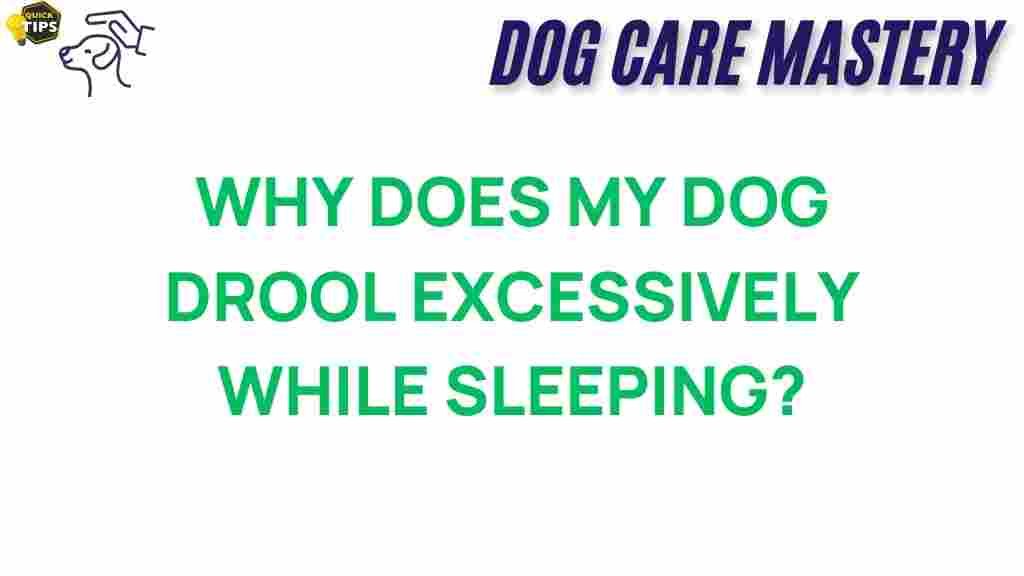The Mystery of Dog Drooling During Sleep Unveiled
Dog owners often find themselves puzzled by various behaviors exhibited by their pets, one of which is dog drooling during sleep. While some dogs may drool occasionally, excessive drooling can be a cause for concern. Understanding the reasons behind this phenomenon can help you ensure your furry friend’s health and happiness.
Understanding Dog Drooling
Drooling is a natural behavior in dogs, but when it becomes excessive, it raises questions about their well-being. Before we dive into why dogs might drool during sleep, let’s explore the basics of drooling in dogs:
- Normal Behavior: Dogs drool for various reasons, including excitement, hunger, and certain breeds (like Saint Bernards and Mastiffs) that are more prone to it.
- Saliva Production: Dogs produce saliva to help with digestion. However, excessive saliva can lead to drooling.
Now, let’s focus on why your dog might be drooling more than usual while they sleep.
Common Causes of Excessive Dog Drooling During Sleep
Excessive dog drooling during sleep can be attributed to several factors. Here are some of the most common causes:
- Dental Issues: Problems like gum disease, tooth decay, or oral tumors can lead to increased saliva production, causing drooling.
- Gastrointestinal Problems: Conditions such as nausea or gastric torsion can lead to excessive drooling.
- Heatstroke: In hot weather, dogs may drool excessively as a way to regulate their body temperature.
- Medication Side Effects: Some medications can increase saliva production as a side effect.
- Stress and Anxiety: Emotional distress can also manifest as drooling, especially during sleep when dogs are more relaxed.
- Foreign Objects: If a dog has something stuck in their mouth, it can lead to drooling while they sleep.
Step-by-Step Process to Address Excessive Dog Drooling
If you’ve noticed your dog drooling excessively during sleep, here’s a step-by-step guide to addressing the issue:
Step 1: Observe Your Dog
Pay close attention to your dog’s behavior. Look for signs such as:
- Changes in appetite
- Unusual lethargy
- Foul breath
- Swelling in the mouth
Step 2: Check for Dental Issues
Examine your dog’s mouth for any signs of dental problems. Look for:
- Red or swollen gums
- Loose or broken teeth
- Visible tartar buildup
If you notice any of these signs, it’s essential to visit your veterinarian for a thorough dental examination.
Step 3: Monitor Eating and Drinking Habits
Take note of your dog’s eating and drinking habits. Are they eating less? Are they drinking more water than usual? Changes in these behaviors can indicate underlying health problems.
Step 4: Evaluate the Environment
Consider external factors that may be causing stress or discomfort for your dog. Make sure your dog has a comfortable and safe sleeping environment, free from excessive heat or noise.
Step 5: Consult a Veterinarian
If excessive drooling persists, it’s time to consult a veterinarian. They can perform a physical examination and may recommend:
- Dental cleaning or extraction
- X-rays to check for gastrointestinal issues
- Blood tests to rule out systemic problems
Troubleshooting Tips for Dog Owners
While you await your vet appointment, here are some troubleshooting tips to help manage excessive dog drooling:
- Maintain Oral Hygiene: Regularly brush your dog’s teeth and provide dental chews to help reduce plaque buildup.
- Stay Hydrated: Ensure your dog has constant access to fresh water, especially in hot weather.
- Avoid Stressors: Identify and minimize any stressors in your dog’s environment, such as loud noises or other pets.
- Monitor Temperature: Keep your dog cool during hot days to prevent heat-related drooling.
- Limit Treats: Avoid giving too many treats that might upset your dog’s stomach.
When to Seek Immediate Help
While some drooling is normal, there are situations where you should seek immediate veterinary care. These include:
- Sudden onset of excessive drooling
- Signs of distress or pain
- Difficulty swallowing or eating
- Vomiting or diarrhea
In these cases, it’s better to be safe and get your furry friend checked out.
Conclusion: Keeping Your Dog Healthy
Excessive dog drooling during sleep can be a puzzling issue for pet owners. By understanding the potential causes and taking the necessary steps to address them, you can help ensure your dog’s health and comfort. Always monitor your dog’s behavior and seek veterinary assistance when needed.
For more information on dog care, you can check out this dog health resource. And if you have any questions or concerns about your dog’s health, don’t hesitate to reach out to your veterinarian.
Remember, a healthy dog is a happy dog!
This article is in the category Behavior and created by dogcaremastery Team

1 thought on “The Mystery of Excessive Dog Drooling During Sleep Unveiled”